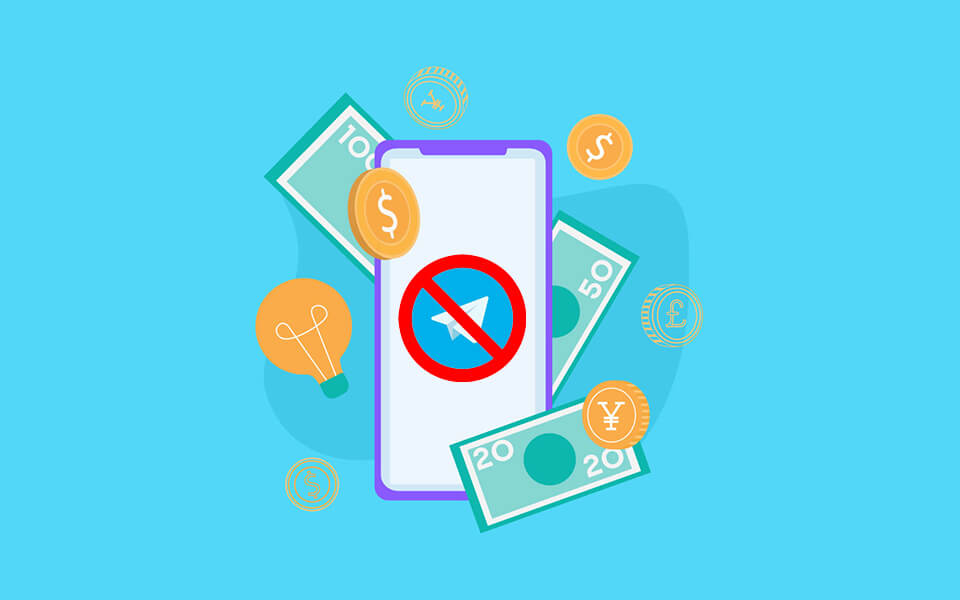
Did you receive Telegram Scam messages that don’t contain a blue tick? Go ahead and report the offending account. Another fraud tactic Telegram users often use offers discounted fake goods that give you an “Incorrect Card Details” error message when you pay. Scroll on to read more about Telegram frauds.
In This Article
- What are Telegram Scams?
- How does the Telegram Scam Work?
- What are the Most Common Telegram Scams?
- The Increase In Crypto Scams On Telegram
- How to Spot a Telegram Scam?
- How to avoid Telegram Scam?
- What to do if you’ve been a victim of a Telegram Scam?
- How to Recover your lost funds from Telegram Scams?
- Why did Morgan Financial Recovery become known for its Telegram Scam Recovery?
- Why Choose Us?
What are Telegram Scams?
Telegram Scams either take place themselves or attempt to mislead users to a risky third-party website.
Telegram attracts scammers because of its widespread use and simplicity. All you need to create an account is a cell number. Traditional phishing scams and advanced bot attacks that pose as real customer service representatives are included in these frauds.
How does the Telegram Scam Work?
Some of the usual Telegram frauds look like this:
- Phishing attacks:
A Telegram user will pose as someone you would typically trust, such as a friend, coworker, or customer service agent, to deceive you into disclosing your Personal Information. - Off-platform fraud:
Someone sends you a link, and you decide to leave Telegram and go to a dangerous website. Your data can be stolen, and there’s even a chance of malware getting installed on your computer. - Telegram bot attacks:
Bots are a hit on Telegram. Scammers employ bot accounts that may be designed on the Telegram network to target weak legitimate accounts quickly. Due to their use by terrorists and child abusers, there were bans for 350,000 bot accounts from the web in 2020. - Crypto scams:
People interested in cryptocurrency and blockchain now frequently use Telegram as their platform of choice. Often, Telegram users can’t access their cryptocurrency wallets or withdraw their bitcoin (BTC), ether, and other coins.
What are the Most Common Telegram Scams?
- SMSRanger Bot:
Cyber Criminals of all skill levels employ the bot SMSRanger to prey on trusting Telegram users. One of the most prevalent Telegram scams involves con artists programming a bot to automatically send notifications that look like they are coming from a bank or other financial institution, like PayPal. The script tricks you into believing that you must give the bot your password or other account details after you interact with it. So naturally, the con artists will only exploit this situation to steal information from you. - SMS Buster:
Like SMSRanger, SMS Buster can gather even more private data, including credit card CVV numbers and credit card numbers, thanks to its script. - Telegram Job Scams:
The term “Telegram job scam,” “Telegram employment scam,” or “Telegram interview scam” refers to one of the most common Telegram messaging scams. In this con, the con artists use phony job postings—typically found on LinkedIn or other job sites—to target job seekers. The con artists are aware that job seekers are frequently in a desperate situation and can therefore be simple prey. After applying for one of these false jobs, the con artists conduct phone interviews via Telegram. They act in a way to track them. Scams involving telegram interviews can operate in various ways, but they always drag you along to give the impression that you are applying for a job. When you accept their job offer, they will ask you for private data like your Social Security number. They then disappear and use these details to steal from you or perform identity theft. - Telegram Crypto Fraud Scams:
To conduct “pump and dump” schemes, Telegram scammers frequently use Telegram. Telegram means that under the guise of providing financial advice, they gather a group of enthusiastic, typically inexperienced, or naive investors in a Telegram group. Then, the con artists stockpile a lot of particular cryptocurrencies before “advising” everyone in the Group to purchase the same ones. Once they have done this, the price increases, and the con artists profitably sell off all the bitcoins, leaving the group members behind. - Telegram Giveaway Scams:
The phony Telegram giveaway scam is another type of Telegram Scam. In this fraud, con artists (or scam bots) approach consumers and pose as a reputable organization launching a giveaway, particularly for cryptocurrency wallets and cash transfer apps. But, of course, you must first give the con artists money to get your “giveaway” reward. And, of course, they leave after that, and you never receive your compensation.
The Increase In Crypto Scams On Telegram
Telegram has become “a haven” for cryptocurrency fraud. In the famous cartoon, a dog typing on a computer says, “On the Internet, nobody knows you’re a dog.” If you don’t use the advice below, it cannot be easy to distinguish facts from the actual thing.
If you find yourself joining a new Telegram channel that claims to be an active cryptocurrency channel, one thing to check is whether you can enter a message or if the track is broadcast-only. If you can’t enter a message, even if it seems like the channel has many users who passionately discuss receiving prizes and awards (these users are known as “shills”), that should be a warning. A broadcast channel will only provide Mute and Unmute options without a space to enter a message and display the loudspeaker icon.
Telegram has two chat options: ( Remember that genuine Admins Never DM First)
- Group messaging is when a large number of users are all conversing simultaneously.
- Direct messaging, also known as private message or inbox, is for a secret one-on-one conversation between two users.
One prominent technique scammers use to contact Telegram users is direct messaging. Even listing their user account in the leading chat group is not required. Instead, they can observe new users or people without technical difficulties in the leading chat group using a secondary account and then use their scam account to send a direct message to those users.
Since honest administrators never start direct discussions with users, users can look at this aspect and avoid the problem. Instead, reliable administrators will always start with a chat in the main channel if a user has a concern or issue that requires some specific assistance. Only then will these admins request a direct message private chat from the user if there is no chance of solving the problem through the main channel.
Therefore, if an admin purports to reach you directly on Telegram, you should take it as a scam attempt. Scrutinizing their usernames is the most excellent technique to spot imposters.
Here’s How a New Telegram OTP Scam Allows Fraudsters to Steal Your Bank Funds
Cybercriminals are now using scripting tools to construct bots in the Telegram service, making Telegram their new target. The use of the software for theft and bank fraud has been made simpler by the hackers using these bots.
- How SMS Ranger works:
- Why it’s a dangerous sign:
- How SMS Ranger works:
The automated message mimics bank behavior and requests customers’ one-time password (OTP) codes in addition to further account specifics. If the effort is successful, Telegram bots will collect the codes and enable hackers to bypass a bank’s OTP verification system. As a result, one’s bank account may be compromised and funds could get transferred. According to our assessment, malicious behavior on Telegram has been observed over the past “several months,” in which users are tricked into disclosing their passwords or verification codes, which are then sent to the hacker operation’s lead. - Why it’s a dangerous sign:
According to our study, some businesses also target other social media sites and banking institutions. Similar tools are not like SMSRanger. Why? It is much easier to use. To configure the quantities and goals while enabling the impersonation of a bank, you only need to be familiar with a few, very basic, Telegram scripting instructions. In essence, SMSRanger can be used by both expert and unskilled cybercriminals. Once a target inputs their phone number, the bot begins to work most of the time. However, when deployed after the cell phone’s response, SMSRanger has a 80% effectiveness rate. In addition to SMSRanger, we found several programs with comparable characteristics, such as SMS Buster, which offers similar features but can gather more data, such as a user’s card number and CVV code. Simple tools are attacking a “secure” service like Telegram such as SMSRanger, which indicates that the number of online Telegram scammers using the network may increase.
How to Spot a Telegram Scam?
Most Telegram users have encountered at least one scam in their lifetime. One thing you can count on: if it seems too good to be true, it probably is. Let’s now determine how many con games you have so far fallen for.
- Fake Telegram channels and groups:
Telegram Scammers frequently create identical copies of legitimate Telegram channels to trick victims into believing they are part of an actual crypto project on Telegram. It’s possible for media to share the same pinned messages, have similar names and profile pictures, and admins with usernames that are almost exact replicas of the real ones. They are frequently configured as “broadcast only,” preventing users from typing messages in the chat. These accounts often advertise freebies, prizes, quick token sales before launches, etc. Admins or members will start contacting you after you join these channels to get you to click a link or share private information so they can steal your identity or access your accounts. - Using Telegram bots for phishing:
Telegram bots use AI and natural language processing to have honest discussions. However, knowing if you are being conned can be challenging because they can be persuasive. For example, hackers call consumers on the phone and utilize bots to persuade them to divulge personal information, login credentials for bank accounts, passwords, and even two-factor authentication (2FA) tokens. These bot attacks typically have a false feeling of urgency, odd phone numbers, grammatical problems, and sensitive information requests. - Crypto giveaways:
Giveaways are a common tactic used to con Telegram users. Scammers pose as cryptocurrency exchanges and offer consumers fake freebies for their banking and personal information—or a fee. Keep in mind that every giveaway necessitates some initial participation from you. Giveaways that you didn’t enter are almost certainly bogus. - Impersonification fake admin accounts:
Because Telegram usernames are by default unique, scammers cannot copy them. They get around this by creating accounts with names resembling actual usernames. When creating a fake username, con artists frequently misspell words and switch letters. For instance, they can substitute the letter “O” with the number zero “0” or the letter “I” with the lowercase letter “L.” Following your inquiry in a public group, lookalike accounts will frequently “assist” you. For example, they attempt to gain access to your account or entice you away from the platform so they may con you using a phishing website. Additionally, it would help if you were wary of administrators or users that send you direct messages rather than posting publicly in the group because DMs make it more challenging to confirm that you’re communicating with the right person. Verify who you are genuinely interacting with. - Pump and dump” crypto channels:
The main goal of “pump and dump” scams is to manipulate the price of cryptocurrencies by working with a big group of participants. The admins may assert that they have inside details. In actuality, they’re attempting to inflate the worth of a possession they own to sell it before it collapses.
How to Avoid Telegram Scam?
On scammers impersonating Commercial admins are unfortunately being reported more frequently. Therefore, here are some guidelines that everyone using Telegram should remember because customer safety is always our top priority:
- Beware of fake administrators/employees on Telegram:
Scammers posing as admins from acclaimed brokerage and exchange firms have been more prevalent in recent weeks. Be cautious because those usernames might be in the bios of fake profiles. Therefore, the names should always be presented with the label username. - Beware of private messages on Telegram:
In the Commerce Community group, scammers frequently contact unwary users via private message while posing as administrators or staff. The Commerce team will NEVER send users a private message first. Don’t provide your Personal Information if you receive a private message from a user whose identity you are doubtful of. - Do not share personal documents:
A genuine commercial agent will never request KYC paperwork, identity documents, selfies, or any other type of personal data that is not required for the KYC process on their website and mobile apps. Only the official site is used to submit KYC papers for verification purposes. Never transmit any private information or documents through unofficial methods. - Do not share account information:
You will never be upfrontly asked for your password or 2FA codes. Never divulge these details to anyone. - Beware of requests for deposits:
Scammers may request that you deposit fiat or cryptocurrency into an account to resolve account issues or for any other reason for which they may claim to need your money. Only the official Commercial platform holds the right to request your deposits. Generally, they never ask for a deposit to resolve your issue. Well-known Commercial brands DO NOT solicit such deposits in fiat currency or cryptocurrencies. - Be vigilant for dubious online offers:
It is a fraud if you are promised a higher-tier account or unique secret trading privileges in exchange for payments of any type, including deposits. Don’t enter personal or account data to secure your budget and money.
What to do if you’ve been a victim of a Telegram Scam?
- You should be alright if all you did was send messages to a scammer or automated system. Cut communication with them before blocking and reporting the fraudulent account.
- How to block a scammer on Telegram: Go to the person’s profile, and select “Block user” by choosing the three dots in the top-right corner of your screen.
- You should exercise extreme caution if you’ve sent the con artist money, clicked on a link, or provided them with personal data.
- Start by keeping an eye out for the warning indicators of identity theft and then follow the instructions for recovering from identity theft.
- Then, get in touch with your bank to warn them about possible fraud. Next, apply for credit monitoring and send freeze requests to Experian, Equifax, and TransUnion, the three credit reporting agencies.
- Inquire about a refund of your payment by lastly contacting the payment processor you used.
How to Recover your lost Funds from Telegram Scams?
If you’ve experienced fraud, you might be able to recover your money. Make a quick call to Morgan Financial Recovery.
Suppose the con artist has assets we can collect. In that case, we can pursue recovery by various methods, including financial complaints and legal actions, from the financial institution that should have discovered and prevented the fraud to the con artist. In addition, we have a network of law firms around the world that can aid in the recovery of concealed cash, and where necessary, we deploy specialists to help trace funds.
Why did Morgan Financial Recovery become known for its Telegram Scam Recovery?
Morgan Financial Recovery helps use current legislation, consumer rights, and specialized solutions to ensure you get the best recovery service possible. Once it has been established that your request is valid and that fraud has occurred, you will be given details and instructions to begin the reimbursement process. We will decide what actions are required to recover your stolen funds successfully. In addition, we provide free consultation as a part of our service during which we will give you everything you need to begin supporting your claim.
Why Choose Us?
“Morgan Financial Recovery” is a reputable business that aids consumers in avoiding Telegram scams. We are still committed to performing thorough investigations, cultivating prestigious legal connections, and gaining our clients’ respect and confidence. The areas of emphasis for Morgan Financial Recovery include:
- preferred timed answers
- internally developed recovery
- awareness-promoting details
- stable and open communication
- “Morgan Financial Recovery” has long-standing relationships with some of the top attorneys in the field of financial extortion, which helps expedite the recovery process.
FAQS
Yes, anyone using Telegram could fall victim to these scams. Scams on Telegram either take place themselves or lure users away from it and onto a risky third-party website. Telegram attracts scammers because of its widespread use and simplicity. All you need to create an account is a mobile number.
It seems too good to be true – for example, a much cheaper holiday than you’d expect. Someone you don’t know contacts you unexpectedly. You suspect you’re not dealing with an honest company – for example, if there’s no postal address. You’ve been asked to transfer money quickly. Scams on Telegram are comparable to the phony texts, emails, and robocalls you get daily.
Any Android email program lets you report this individual, including Outlook or Gmail. Please submit a message by writing it down to telegram.org. Describe the abusive incident in a statement. For the abuse team to know how to respond, be thorough in your description.
Have you fallen for the Telegram Scam? Then, contact Morgan Financial Recovery to recover your lost funds. We have dedicated scam recovery experts to help you.


